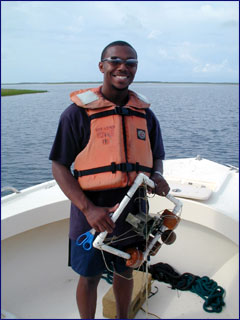|  Napoleon
Paxton assisted NOAA Beaufort Laboratory scientists
in determining the maximum depth of seagrass beds along
the Southern Outer Banks. During his summer internship
he was mentored by Dr. J. Kenworthy (vitae)
and Dr. Patrick Biber (vitae).
The goal of this project was to develop a long-term
record of seagrass bed extent, focusing primarily on
the historical changes that have occurred to the deep-edge,
and tie this in with historical changes in water-quality. Napoleon
Paxton assisted NOAA Beaufort Laboratory scientists
in determining the maximum depth of seagrass beds along
the Southern Outer Banks. During his summer internship
he was mentored by Dr. J. Kenworthy (vitae)
and Dr. Patrick Biber (vitae).
The goal of this project was to develop a long-term
record of seagrass bed extent, focusing primarily on
the historical changes that have occurred to the deep-edge,
and tie this in with historical changes in water-quality.
Introduction
to Research
What
are Seagrasses
Seagrasses are vascular plants that grow completely
underwater. They are a part of a larger group of underwater
plants called SAV (Submerged Aquatic Vegetation). SAV
have special adaptations to help them survive in the
aquatic environment. The leaves and stems lack the waxy
cuticle that is characteristic of most terrestrial plants
to allow for easy exchange of gasses and nutrients between
the plant and surrounding water. Specialized air-filled
cells, called aerenchyma, are present in the leaves
and stems and provide the plant with additional buoyancy
and support. Seagrasses are distinguished from other
SAV because seagrasses require a certain amount of salinity
to survive.
Importance
of Seagrass
There are many important ecological roles of seagrass
in the aquatic environment. They provide food and habitat
for waterfowl, fish, shellfish, and invertebrates. The
seagrasses serve as nursery habitat for many species
of fish, such as young spot and striped bass, which
seek refuge from predators in the grass beds, blue crabs
also hide in seagrass. Seagrasses provide oxygen in
the water column as part of the photosynthetic process.
Seagrasses filter and trap sediments that can cloud
the water and bury bottom-dwelling organisms, such as
oysters. They protect shorelines from erosion by slowing
down wave action, and they remove excess nutrients such
as nitrogen and phosphorous, that could fuel unwanted
growth of algae in surrounding waters. These nutrients
are also required for seagrass growth and reproduction,
but in much lower water-column concentrations.
Common
types of Seagrass
The two types of seagrasses along the Southern Outer
Banks are eelgrass (Zostera marina), and shoalgrass
(Halodule wrightii). Eelgrass is the most common seagrass
in this area and it is more prevalent in temperate climates.
Hot weather puts stress on this species of seagrass.
Shoalgrass is a more tropical seagrass and is more prevalent
during the summer months on the Outer Banks. Both of
these species of seagrass are normally found in the
same grass beds.
This
paper can be found in it's entirety at: http://nia.ecsu.edu/ureoms2004/teams/noaa/npaxton_summer04.pdf |